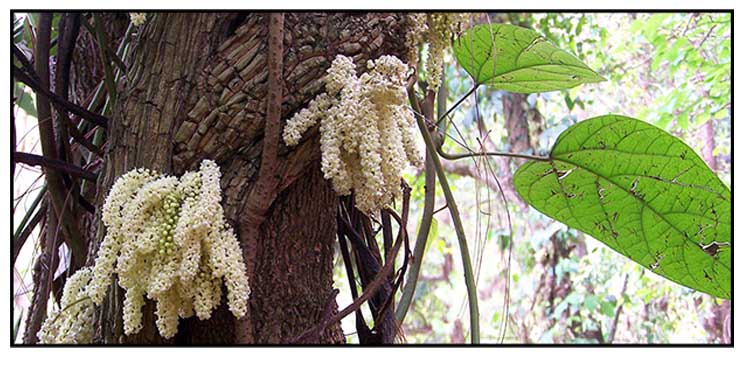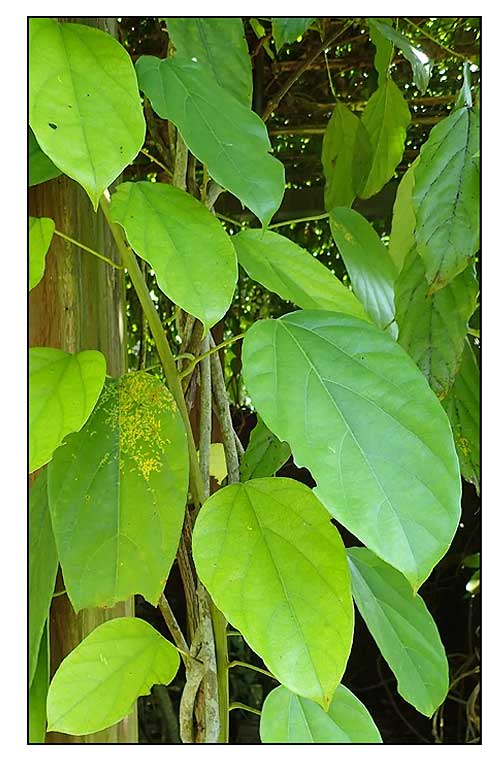 Gen info Gen info
• Tinomiscium is a genus of flowering plants in the family Menispermaceae. Native range is Tropical and Temperate Asia.
• A primary food source for the Banded Leaf monkey and acts as host plant for the Eudocima discrepans moth.
Botany
• Bayating is a stout, woody vine. Stem has a gray bark and milky sap. Leaves are thin, ovate, 15 to 25 centimeters long, and about 10 centimeters broad, smooth except at the nerves beneath, with a broad rounded base and pointed tip on long petioles, up to 15 centimeters in length. Flowers are yellow, fragrant, about 1 centimeter across, occurring in considerable numbers on long, slender, drooping branches which grow in clusters, usually on the stems.
 • Large woody climber to 30 m; young stems conspicuously striate, ferrugineous-pubescent at first, later glabrescent. Leaves ovate to broadly ovate or elliptic, base truncate to cordate or obtuse, apex acuminate, 11–25(–29) by 4.5–20 cm, base 3–5-nerved with 2–3(–4) pairs of distal lateral nerves, glabrous above, puberulous to glabrous below, stiffly papyraceous; petioles 6–21 cm. Inflorescences arising several together from protuberances on old stems, racemose, (5–)8–28(–35) cm, usually ferrugineous-tomentose. Male flowers on puberulous pedicels, 2.5–5 mm; outer sepals 3, triangular-ovate to narrowly triangular, 1–2 mm long, lightly puberulous to glabrous; 6 main inner sepals white to yellow, elliptic, 4–5 mm long, reflexed at anthesis, glabrous or externally usually lightly puberulous; petals broadly elliptic, 2.5–3.5 mm long, erect and contiguous at anthesis, concave with lateral edges incurved, glabrous; stamens 2–2.5 mm, anthers either immersed in the thickened connective or rather prominent. Female flowers: sepals and petals as in male; staminodes linear-oblong, acute, 3 mm; carpels curved-ellipsoidal, 2 mm long; stigma shortly multi-lobed. Drupes at first green with white spots, later white to yellow (or orange), containing white latex, radiating from the discoid carpophore terminating pedicels 1–2 cm, drying ± compressed-ellipsoidal, glabrous, base narrowed into a short stalk; endocarp compressed, narrowly to broadly elliptic or subovate in outline, 2–3.5 by 1–2 cm, base rounded to obtuse, apex obtuse to sharply acute, surface obscurely to strongly rugose or rugulose. (e-Flora of Thailand) • Large woody climber to 30 m; young stems conspicuously striate, ferrugineous-pubescent at first, later glabrescent. Leaves ovate to broadly ovate or elliptic, base truncate to cordate or obtuse, apex acuminate, 11–25(–29) by 4.5–20 cm, base 3–5-nerved with 2–3(–4) pairs of distal lateral nerves, glabrous above, puberulous to glabrous below, stiffly papyraceous; petioles 6–21 cm. Inflorescences arising several together from protuberances on old stems, racemose, (5–)8–28(–35) cm, usually ferrugineous-tomentose. Male flowers on puberulous pedicels, 2.5–5 mm; outer sepals 3, triangular-ovate to narrowly triangular, 1–2 mm long, lightly puberulous to glabrous; 6 main inner sepals white to yellow, elliptic, 4–5 mm long, reflexed at anthesis, glabrous or externally usually lightly puberulous; petals broadly elliptic, 2.5–3.5 mm long, erect and contiguous at anthesis, concave with lateral edges incurved, glabrous; stamens 2–2.5 mm, anthers either immersed in the thickened connective or rather prominent. Female flowers: sepals and petals as in male; staminodes linear-oblong, acute, 3 mm; carpels curved-ellipsoidal, 2 mm long; stigma shortly multi-lobed. Drupes at first green with white spots, later white to yellow (or orange), containing white latex, radiating from the discoid carpophore terminating pedicels 1–2 cm, drying ± compressed-ellipsoidal, glabrous, base narrowed into a short stalk; endocarp compressed, narrowly to broadly elliptic or subovate in outline, 2–3.5 by 1–2 cm, base rounded to obtuse, apex obtuse to sharply acute, surface obscurely to strongly rugose or rugulose. (e-Flora of Thailand)
Distribution
- Native to the Philippines.
- Found in Pangasinan, Quezon, and Laguna Provinces in Luzon; in Lanao and Davao Provinces in Mindanao, in forests at low and medium altitudes.
- Found on various soils and substrates, including limestone, in evergreen forests from sea level to 1400 m altitude.
- Also native to Assam, Borneo, China South-Central, China Southeast, Jawa, Malaya, Myanmar, New Guinea, Nicobar Is., Sumatera, Thailand, Vietnam. (10)
 Constituents Constituents
- Yields a crystalline compound, Picrotin, a tutinolide sesquiterpene lactone.
-
A bitter principle has been isolated from the seed of Tinomiscium philippinense, Anamita cocculus, Menispermaceae, composed of one mole of picrotoxin and one mole picrotin into which it readily separates. (see study below) (8)
- Picrotoxin may also be used as an antidote to barbiturates. (5)
- The diterpene tinophyllone was isolated from the root and bark. (9)
- Hydrodistillation and GS-MS study of leaves and stems for essential oil yielded 0.06% and 0.04% (v/w) respectively. Major components of leaves and stems were relatively similar: ß-bisabolene (11.43 and 13.80%), trans-α--bergamotene (6.52 and 6.61%), geranyl acetate )(6.12 and 5.77%), (E)-caryophyllene (5.04 and 4.73%), δ-cadinene (4.10 and 5.27%), (E,E)-α-farnesene (4.54 and 4.665%), and α-zingiberene (3.85 and 4.50%). (see study below) (13)
Properties
-
Picrotoxin has been reported to have CNS stimulant effect, insecticidal and nematocidal properties.
-
Studies have suggested antiangiogenic, antibacterial properties.
Parts used
Sap, fruit.
Uses
Edibility
- In Malaya, seeds are reported as edible and sweet.
Folkloric
- In the Philippines, the white milky sap diluted with water used as eyewash. (7)
- In Vietnam, the milky exudate is used for dental caries.
- In Malaysiia, roots are boiled and applied externally for rheumatism; root decoction drunk for the same purpose. In Terengganu State, wet ground roots are applied to a runny nose. In Jawa, roots and stems are traded as 'kayu seriawan', meaning wood for sprue. Latex also used to alleviate sprue and fever. In Sumatra, leaves are used as dressing for severe cuts. (15)
- In Sarawak, root decoction drunk to treat hypertension.
Others
• Poison: Fruit used as fish poison. (•) In southern Sumatra, pounded stems mixed with rice are used as rat poison. Pounded bark used to stupefy fish. (15)
Studies
• Crystalline Principle / Constituent: Roots yielded a crystalline principle in the form of white needles. On elementary analysis and molecular weight determinations lead to the molecular formula C21H26O6. A tertiary phenolic alkaloid and a quaternary base are also present in the roots. (2)
• Tinophyllone: Study isolated tinophyllone, a diterpenoid, with a formula of C21H26O6.
• Anti-Angiogenic / Antibacterial / Toxicity Evaluation / Leaves: Study evaluated the toxicity profile, anti-angiogenic and antibacterial activity of crude and semi-crude leaf extracts of T. philippinense. A dichlormethane leaf extract at 1000 µg/disc showed the highest antiangiogenic activity with 37.46% inhibition. All fractions exhibited bacteriostatic and bactericidal effect on three bacterial strains, with P. aeruginosa showing higher sensitivity to the dichlormethane semi-crude extract. The ME of leaves was non-toxic at maximum dose of 5000 mg/kg. (4)
- Picrotoxin / Statement of Hazardous Nature: A bitter principle has been isolated from the seed of Tinomiscium philippinense and Anamita cocculus, composed of one mole of picrotoxin and one mole picrotin into which it readily separates. It was used therapeutically as a central and respiratory stimulant; as an antidote to barbiturate poisonings, now considered dangerous. Report presents an emergency overview, risks, potential health effects, acute health effects. Picrotoxin may cause severe toxic effects if swallowed; animal experiments have shown less than 5 grams may be fatal. At high doses, it is neurotoxic. Report presents basic and advanced treatment principles. (8)
• Antimicrobial / Essential Oil / Leaves and Stems: Study evaluated the leaves and stems of T. petiolare for essential oils and antimicrobial activity. Hydrodistillation and GS-MS study of leaves and stems yielded 0.06% and 0.04% (v/w) respectively. Antimicrobial activity showed stem essential oil displayed moderate activity against Staphylococcus aureus ATCC 6538 with MIC of 200 µg/mL, while both EOs inhibited the growth of Pseudomonas aeruginosa ATCC 9027 with MIC of 200 µg/mL. (see constituents above) (13)
Availability
Wild-crafted.
|

![]()





 Constituents
Constituents